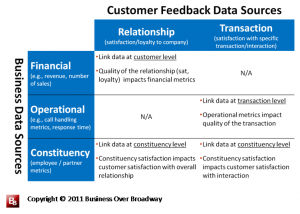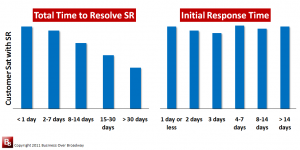Business linkage analysis is the process of linking disparate business data sources together for the purposes of understanding the relationships between them (See Figure 1). For operational linkage analysis, we are interested in understanding the relationship between customer feedback metrics and operational metrics. Demonstrating the statistical relationship between customer feedback metrics and operational metrics is useful for three reasons:
- Build/Identify customer-centric business metrics: Operational linkage analysis helps you identify/create key operational metrics that are statistically linked to customer satisfaction.
- Manage customer relationships using objective operational metrics: Driving business growth now becomes a process of using the operational metrics to manage customer relationships. Linkage analysis will help in setting appropriate operational performance goals (using operational metrics) that ensure customers will be satisfied.
- Reward employee behavior that will drive customer satisfaction: Because of their reliability and specificity, operational metrics are good candidates for use in goal setting and employee incentive programs. Rewarding employee performance based on customer-centric operational metrics ensures employees are aligned with the needs of the customers.
Operational and Customer Feedback Metrics
There are many types of operational metrics that are commonly tracked in support and call centers. These metrics include:
- First Call Resolution (FCR)
- Number of calls until resolution
- Call handling time
- Response time
- Abandon rate
- Adherence & Shrinkage
- Average talk time
- Average speed of answer (ASA)
In operational linkage studies, we use customer feedback metrics from a transaction-based survey where responses are associated with a specific transaction (typically, in a call-center environment) and reflect satisfaction with a that specific transaction (or satisfaction with other components of the transaction – knowledge of call center rep). So, for any given transaction, we have two kinds of information, 1) the operational metrics surrounding that transaction and 2) customer’s satisfaction with that transaction.
Linking Operational Metrics to Customer Metrics
Once we have these two sources of business data, we organize the data so that each transaction (or group or time period) has a score on the operational metric and the customer feedback metric. The example in Figure 2 represents the linkage at the transaction level. For each transaction (interaction), we have two pieces of information, operational metric (x) and customer feedback (y).
Results
The output of the analyses will illustrate the relationship between operational metrics and customer satisfaction. When presenting the results of the analysis, I like to illustrate the relationship in graphical form. Below are two figures that show the relationship operational metrics and customer satisfaction.
Figure 3 illustrates the relationship between number of calls to resolve the service request (SR) and customer satisfaction with that SR. We found that SRs that required more calls from the customer resulted in lower levels of satisfaction with SRs compared to SRs that required fewer calls from the customer. Specifically, customers were satisfied until they had to call four times. As a result, senior executives were able to implement a performance standard for SR resolutions (Resolve SRs within 3 telephone calls).
Figure 4 illustrates the relationship of two operational metrics (initial response time and total time to resolve SR) with customer satisfaction with SRs. A client wanted to identify which operational metric was more important to customers (e.g., predicted customer satisfaction better). As you can see in the figure, initial response time had no impact on customer satisfaction; customers were just as satisfied with SRs that had a long initial response time as they were with SRs that had a shorter initial response time. On the other hand, total time to resolve the SR had a large impact on customer satisfaction with the SR. Customers were significantly more satisfied with SRs that were resolved within one week compared to SRs that took longer to resolve. From these results, it appears that only one of these metrics were important to customers (Total time to resolve SR).
Using the results of these analyses, senior executives were able to identify the call center operational metrics that impact customer satisfaction. As a results, senior executives wanted to understand how other operational metrics impacted customer satisfaction with the SR process in order to build a performance dashboard where only the important, customer-centric, operational metrics are displayed and tracked.
Summary
Operational linkage analysis helps show the causes of customer satisfaction. In my examples, the linkage analyses showed us that not all operational metrics are created equal. Companies turn to operational linkage analysis to identify those objective, measurable aspects of the transaction that drive customer satisfaction. Once identified, operational metrics can be used to manage customer relationships by incentivizing employees on operational metrics that matter to the customer.
Next week’s blog will be dedicated to illustrating linkage analysis using constituency metrics and customer feedback metrics.








Your paper touches on a very important but, in my experience, little practiced topic. Many people put the work of linking VoC and other measures in the ‘too hard’ box. It is vital if customer experience and VoC investments are to be judged effectively alongside other demands on limited investment dollars.
I have set put a few ways companies can build their own models in a paper ‘Linking Insight and Profit’. A copy can be accessed via the Clicktools page on Linkedin or Facebook.
Regards
Dave J